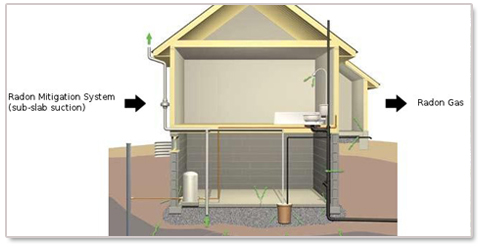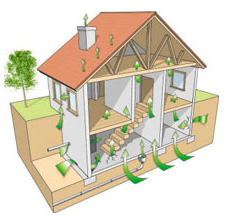Radon in Iowa is  a health threat. The US Environmental Protection Agency
a health threat. The US Environmental Protection Agency
has provided a guide to the physician’s of Iowa as to the the risks and
consequences of exposure to radon. The radon levels in Iowa are some of the
highest in the country. The entire state of Iowa is in the red zone,
meaning that every county in Iowa has above average radon levels.
Radon is a radioactive gas that you cannot see, smell or taste. Radon is
released by uranium-bearing rocks and soil as the uranium undergoes natural
radioactive decay. The gas moves through the soil and reaches the outdoor
air and can accumulate under the slabs and foundations of homes and
businesses. The radon will enter the home or business through cracks and
openings, and becomes trapped inside. This can cause high indoor
concentrations. When this radon is inhaled, it can become a danger to the
lungs. Radon is the second cause of lung cancer, second only to cigarette
smoking. Here are some of the ways that radon will enter your home or business:
- Cracks in concrete slabs
- Floor-wall joints
- Spaces behind brick veneer walls that rest on uncapped hollow-brick foundation
- Mortar joints
- Loose fitting pipe
- Open tops of block walls
- Pores and cracks in concrete blocks
- Exposed soil, as in a sump
- Weeping drain tile, if drained to open sump
Physician’s are well aware of how radon can affect the health of their
patients. That is why they encourage patients to test for radon levels in
their homes. Knowing the levels in your home and having radon mitigation if
the levels are over 4 picocuries per liter (pCi/L) is important. AmeriServ
Radon Mitigation of Iowa can come and test your home or business and offer
radon mitigation if we find the levels to be high.
SOLUTIONS FOR HIGH RADON LEVELS
The professionals at AmeriServe Radon Mitigation of Iowa has the testing equipment and mitigation solutions for you in Iowa. We have short term testing and long term testing. The short term testing is used when there is a need to know the results quickly as in a real estate deal. There are a few method of doing short term testing:
- Charcoal canisters
- Electret ion chamber
- continuous monitors
- Liquid scintillation
Long term testing will last for 90 days or longer. The benefit of long term testing is that it will give a more accurate, year round average of the radon levels in your home. This prevents false negative or positive results because of a peak or valleys in the radon levels.
After testing, if the levels in your home or business are above 4pCi/L, the experts at AmeriServ will perform radon mitigation. The process of radon mitigation removes radon from your home and expels it to the outdoor air. To do this, we drill a hole in the foundation or slab, creating a suction point. Then a PVC pipe is connected through the hole to use as a vent for the radon gas. A fan is then connected to this system to ensure air flow in the right direction. this is usually installed in the attic of your home.
Don’t let radon in your Iowa home become a health issue for you and your family. Let AmeriServ conduct radon testing and give you the solution you need to remove the radon from your home or business.
AmeriServ Radon Mitigation of Iowa has a team that has been professionally trained by the State of Iowa and is certified by the Iowa Department of Public Health. Don’t hesitate to contact us for your radon testing and radon mitigation needs. We have the solution for you! Contact us today!
 Our Response to COVID-19
Our Response to COVID-19 

